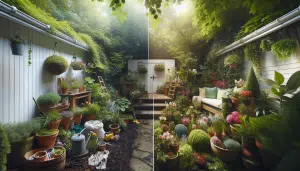Secrets You Might Not Know About Indoor Plant Care
Lily Carter November 1, 2025
Indoor plants offer beauty and cleaner air, but their care holds some surprises. Discover the practical guide to houseplant maintenance, watering tips, soil hacks, and the benefits of indoor greenery—unlocking a thriving home oasis for all skill levels.
Popular Benefits of Indoor Plants
Indoor plants do far more than add color to living spaces. They help purify the air by reducing pollutants and providing a calming, nature-inspired environment. Studies indicate that having greenery indoors can lower stress and contribute to an improved sense of well-being. This combination makes houseplants an appealing choice for both apartments and larger homes, regardless of climate or location.
Another often-overlooked advantage of indoor plants is their potential to enhance productivity. Research shows that even a single potted plant in a workspace can make people feel more energized and help with concentration. The presence of living plants is also linked to reduced noise levels, acting as subtle sound barriers. Many people notice improved focus and creativity when nurturing greenery inside their homes.
Houseplants can also support indoor humidity control, particularly during dry seasons. Transpiration, a process in which plants release moisture, can add natural humidity to indoor air. This benefit is particularly valuable for residents in arid climates or homes with heating systems that cause dryness. With so many advantages, it’s no wonder indoor plants remain a consistent trend in home and garden circles (https://www.epa.gov/indoor-air-quality-iaq/air-cleaners-and-air-filters-home).
Choosing the Right Houseplants for Beginners
For those new to plant care, selecting the most forgiving varieties is an essential first step. Hardy houseplants like snake plant, pothos, and spider plant are excellent choices because they tolerate some neglect and thrive in a variety of lighting conditions. Choosing beginner-friendly species helps build confidence and sets the stage for long-term indoor gardening success.
Light availability is a significant factor in plant selection. Low-light options, such as ZZ plant and heartleaf philodendron, work well in spaces without abundant sunlight. Conversely, succulents and aloe vera require brighter spots, typically near south-facing windows. Assessing the environment before purchasing any plant can save both time and future disappointment.
It’s also wise to consider care requirements such as watering frequency, humidity preferences, and pest resistance. Some plants demand regular misting or specific soil blends, while others are resistant to common indoor pests. This attention to detail can prevent frustrations and keep plants beautifully vibrant. Eventually, as skills grow, adding rarer or more demanding varieties offers a rewarding new challenge for indoor gardeners (https://hgic.clemson.edu/factsheet/selecting-indoor-houseplants/).
Watering Mistakes and Expert Tricks
Overwatering is a common challenge for indoor plant owners. Surprisingly, most houseplants prefer drying out between waterings. Signs of excess water include yellowing leaves, root rot, and a musty smell from the soil. Allowing the upper inch of soil to dry before the next watering can prevent these problems and promote healthier growth.
Another expert tip is to use room-temperature water to avoid shocking plant roots. Collecting rainwater or letting tap water sit overnight can help dissipate chlorine and other chemicals, further benefiting sensitive plants. Placing a saucer beneath pots not only protects surfaces but also allows excess water to drain, a crucial element for root health.
Some plants, like ferns and calatheas, thrive with higher humidity levels. Grouping pots or placing them on a pebble tray with water beneath is a clever way to boost moisture around foliage. Investing in a moisture meter helps to judge soil dampness more accurately, avoiding the need for guesswork. Small changes to watering routines often yield impressive results and help prevent both underwatering and overwatering (https://extension.psu.edu/houseplant-watering-guide).
Light and Placement for Lush Growth
Managing light exposure is key to robust plant health. Every houseplant species comes with its own requirements, ranging from direct sun to deep shade. Understanding which direction windows face and monitoring light intensity during different times of day can result in dramatic improvements in plant vitality and growth patterns.
Sheer curtains offer an effective way to diffuse intense sunlight and protect plants that are sensitive to direct rays. Rotating pots every week or two encourages even growth and prevents the stretching or leaning commonly seen in plants reaching for light. For rooms lacking windows, full-spectrum grow lights can simulate natural sunlight, making plant care possible in almost any room.
Furniture and decor arrangement also impacts plant placement. Avoid situating plants near cold drafts or heat sources like radiators, as extreme temperatures can cause foliage damage. By observing plant reactions to different spots, indoor gardeners can discover the most suitable positions for lush foliage and steady development (https://extension.umn.edu/houseplants/growing-indoor-plants-using-artificial-light).
Soil, Fertilizer, and Repotting Insights
Soil selection plays a surprisingly significant role in plant success. General-purpose potting mix works for most species, but cacti, orchids, and certain palms benefit from specialty blends designed for drainage or aeration. Fertilizing is another aspect to consider—using diluted liquid plant food every few weeks during active growth periods maximizes leaf and root development for vigorous, healthy specimens.
Repotting is necessary for long-term plant health when roots begin to crowd or break through drainage holes. Spring and early summer offer ideal conditions for repotting, minimizing stress on plants while encouraging new growth. Choosing a pot just slightly larger than the root ball prevents waterlogging and supports natural expansion.
For beginners, repotting can seem daunting, but it’s a straightforward process with lasting benefits. Removing old, compacted soil and trimming decayed roots gives plants a boost and reduces the risk of disease. Over time, understanding individual plant preferences for soil, feed, and pot size becomes second nature, helping to cultivate a thriving indoor garden (https://extension.illinois.edu/news-releases/right-soil-indoor-plants).
Common Pests and Natural Solutions
Houseplants can attract a variety of pests, ranging from fungus gnats and spider mites to mealybugs. These issues often occur when plants are under stress or when new green additions arrive from nurseries. Quarantining new plants and regularly inspecting leaves for small insects or sticky residue is recommended for early detection and intervention.
Simple approaches to pest management include rinsing leaves with a gentle water spray or dabbing affected areas with isopropyl alcohol. In some cases, natural solutions like insecticidal soaps or neem oil can address infestations without harming the plants or environment. Keeping the growing environment clean—wiping down leaves, removing dead foliage, and not allowing water to pool—also deters pests.
For persistent problems, adjusting watering patterns or humidity may interrupt pest life cycles. Removing severely infested leaves and repotting with fresh soil can halt major outbreaks. Practicing these methods helps maintain a naturally healthy indoor garden, minimizing reliance on chemical treatments (https://www.gardeningknowhow.com/houseplants/hpgen/common-houseplant-pests.htm).
References
1. United States Environmental Protection Agency. (n.d.). Air Cleaners and Air Filters in the Home. Retrieved from https://www.epa.gov/indoor-air-quality-iaq/air-cleaners-and-air-filters-home
2. Clemson Cooperative Extension. (n.d.). Selecting Indoor Houseplants. Retrieved from https://hgic.clemson.edu/factsheet/selecting-indoor-houseplants/
3. Penn State Extension. (n.d.). Houseplant Watering Guide. Retrieved from https://extension.psu.edu/houseplant-watering-guide
4. University of Minnesota Extension. (n.d.). Growing Indoor Plants with Artificial Light. Retrieved from https://extension.umn.edu/houseplants/growing-indoor-plants-using-artificial-light
5. University of Illinois Extension. (n.d.). The Right Soil for Indoor Plants. Retrieved from https://extension.illinois.edu/news-releases/right-soil-indoor-plants
6. Gardening Know How. (n.d.). Common Houseplant Pests. Retrieved from https://www.gardeningknowhow.com/houseplants/hpgen/common-houseplant-pests.htm







